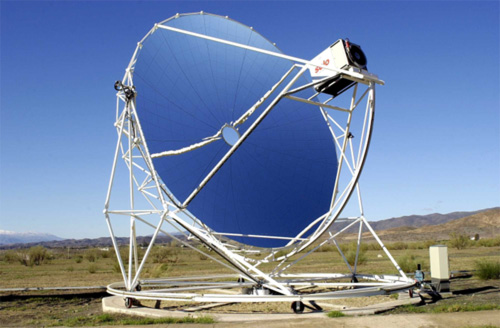There's a little ray of hope on the global warming front, thanks to the unlikely rediscovery of a forgotten engine, a rusty artifact dating back to the earliest days of the industrial revolution.
In desert regions around the world, large parabolic shaped mirrors are beginning to crop up that may finally make solar energy deliver on its promise. What makes them so special from other solar complexes is the device they're connected to -- an updated version of a 19th-century engine that used to pump water to the rooftop storage towers dotting New York City's skyline. A Stirling engine, no larger than a household washing machine, converts sunlight into electricity six times more efficiently than other technologies in common use. When scientists do the math, the numbers begin to add up. In fact, researchers at Sweden's Chalmers Institute of Technology estimate that the entire world's daily consumption of electricity could be supplied by a Stirling solar farm equivalent to 6 percent of the Sahara Desert area.
 You've probably never heard of the Stirling engine before and for good reason. The technology became as passé as the VHS when Henry Ford, John D. Rockefeller and the other titans of industry got together in the early 1900s and made the gasoline-powered internal combustion engine the standard for the burgeoning auto industry. The deal made sense at the time, since oil was regarded as so plentiful and cheap. And given the tortoise-like acceleration of the early generations of the Stirling engine, it wouldn't have been a suitable choice to power cars.
You've probably never heard of the Stirling engine before and for good reason. The technology became as passé as the VHS when Henry Ford, John D. Rockefeller and the other titans of industry got together in the early 1900s and made the gasoline-powered internal combustion engine the standard for the burgeoning auto industry. The deal made sense at the time, since oil was regarded as so plentiful and cheap. And given the tortoise-like acceleration of the early generations of the Stirling engine, it wouldn't have been a suitable choice to power cars.
Back in 1816, Scottish clergyman named Robert Stirling had invented the device as a safer alternative to exploding steam engines and thus prevent the deadly accidents that plagued British mines, quarries and foundries. A few decades later, John Ericsson, the Swedish-born engineer, inventor of the propeller, and who designed the ironclad Civil War warship U.S.S. Monitor, brought a commercial application of the Stirling engine to the United States. More than 100,000 engines were in operation by the late 1800s.
What made the Stirling effective almost two centuries ago is also its advantage in upgraded form today: the engine's high efficiency in converting thermal energy into propulsion. The principle is simple. Start with a sealed chamber of gas. By applying heat to one end, the gas first expands and then contracts when interacting with the cooler end of the cylinder. The oscillating cycle between the hot and cold drives a piston to generate the mechanical energy. Unlike the gasoline engine, the Stirling engine requires no carburetor, ignition system or valves.

Credit: Cleanergy AB
Contemporary Swedish scientists who have followed in John Ericsson's footsteps have solved many of the shortcomings that doomed the engine in its earlier incarnations. The Swedish Navy, in fact, has several submarines and other vessels that are powered by large Stirling engines. In the 1970's, one leading Swedish expert who was ahead of his time tried to get the American automobile industry on board to its environmental advantages. One of the automakers gave him a team and some lab space for a while. Outside of taking some members of the U.S. Congress in a spin around the Capitol in a Stirling-equipped sedan, the effort went predictably nowhere with opposition by the usual vested interests of preserving the status quo.
Defenders of business as usual have stopped a number of promising technologies cold in their tracks (Exhibit A: the 2006 documentary film "Who Killed the Electric Car?"). But today, for the first time in recent modern history, the global economic crisis has finally opened the doorway of opportunity. Economic reality combined with political will beyond lip service are finally giving technologies like Stirling solar power a chance to be taken more seriously. Even with oil prices plummeting for the moment, few are in denial that long-term solutions to achieve renewable clean energy are needed quickly, Nor does it hurt that many see such green industries as one of the few logical ways to generate jobs, restart empty factories and jumpstart local economies.
Sweden, the land that gave us IKEA, Volvo and ABBA, is well underway to take leadership in this technology. It's a natural development given that the country has continued research over the last several decades to work the kinks out. The large naval engines produced by the Swedish shipbuilder Kockum work perfectly but are not of realistic scale for the solar installations. A 9 kilowatt Stirling model originally designed by Kockum and now owned by the newly formed Swedish corporation Cleanergy AB is what most experts agree is the best format. It also is the only one with a reliable track record, with more than two million field operating hours in Germany and in the desert regions in Southern Spain. Other models by an American company Stirling Energy Systems are in use in the deserts of California and Arizona.
The Stirling energy systems are also in demand for other uses besides providing electricity for general use. Gulf countries are looking at it as well for desalinization of sea water, and other regions with unreliable rural electricity grids are looking for Stirling solar stations to power essential cell phone radio communications stations where costly and polluting diesel generators are currently the only option. For climates where sunlight is less plentiful, Stirling engines are also providing cleaner and renewable energy options that use sewage, biogas and pellets from forestry waste as fuel.
Foreign delegations are coming to Sweden and orders are beginning to flow in even while Cleanergy's factory is still in the building stages in the Swedish city of Åmål. With production beginning this year with the target of manufacturing of 15 thousand Stirling units in its first three years, Cleanergy will be the first of hopefully many large scale production facilities of Stirling power plants worldwide.
If successful, Stirling solar energy will show us the ultimate example of the benefits of recycling, all from a rusty old engine from the junk heap of technology that could very well save the planet.
